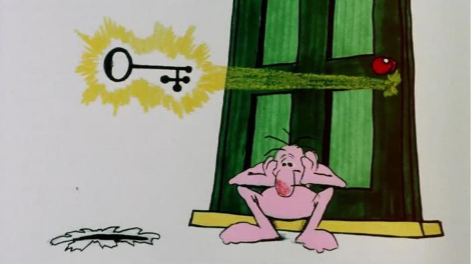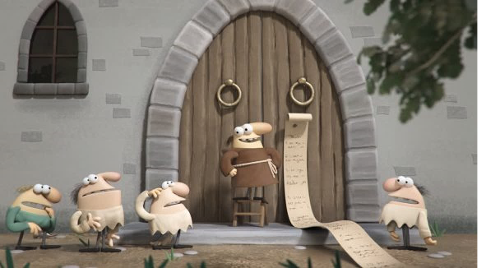
In 1910, Congregation minister Herbert Jump published his Religious Possibilities of the Motion Picture, preaching boldly for producing short visual parables that could teach faith and ethics. Throughout the 20th century, numerous animated films sought to inculcate viewers in matters of creed and praxis, and tell parables. Churches would find them useful in instructing congregations of church doctrine, history, and practice. For example, under the rubric of Screen Test, ribald British animator Bob Godfrey and Anglican Church writer, Norman Stone, designed several cartoon spots, The Hand and The Key (1976), on the Providence of God. The cartoons radiate a playfully provocative set of theological images, with a little bit of sex thrown in. With Bob Godfrey’s wild earthy humor, and a catalog of grunts, bangs, explosions, a hapless protagonist endures, as the film teaches, the “foibles and perversity of his soul’s struggle against God”.

The United Methodist Church documented its own history by producing Clayride: A Gallop through Methodist History (Greg Killmaster, 1984), a lively and quite amusing clay animation history of the Methodist Church, condensing two hundred years of American Methodist history under five minutes. The Lutherans hired the Tumblehead Animation Studio to celebrate A Most Precise and Nuanced Look into the Life of the Man, Legend, and Visionary, Martin Luther (Magnus Moller, 2017) to commemorate the 500-year anniversary of the Protestant Reformation. Although more of a spoof, but still quite a useful instructional film on Luther’s challenges to Friar Tetzel, The Reformation Polka (Sam Mulberry, 2014) covers the Reformation with a delightfully “irritating little song” that repeats a catchy chorus of “Oh! Papal Bulls, Indulgences, and Transubstantiation, speak your mind against them and face excommunication.” Lutherans presented their delightfully satirical, but limited, animation of St. Patrick’s Bad Analogies (Hans Fiene, 2013) in which the patron saint to the Irish tries to explain heresies to two grumpy and caustic yokels, red-headed, balding twin monks, Donall and Conall, who know more than they let on, with their “That’s Modalism, Patrick.” Fiene explained that he was trying to teach the faith “by making fun of stuff.”
In 1947, former Warner Bros. animator Frank Tashlin wrote and directed an obscure anti-nuclear stop-motion puppet short The Way of Peace. Also funded by the Evangelical Lutheran Church in America, it began with a paraphrase of Genesis and a hymn celebrating “O God, our Father, we sing our praise to Thee”. Tashlin employed actor and WWII conscientious objector, Lew Ayres, to chronicle how man’s inhumanity to humankind could lead to the destruction of Earth. “In the beginning, God created the Heavens and the Earth and all that was good,” intones the narrator, culminating in God’s most beloved creation, Man, to whom He has given all his wonders to use with his free will and intelligence, and to live in the image of God and the spirit of God. Man found peace within himself and his neighbor, and “God saw that this was good.” Soon man ignored God and built a high stone wall, separating himself from God. Completely shutting out the light of God, and running into shadows of his own making, he found no peace.
This animation builds to its crescendo showing Man behind his walls of hatred, envy, fear, greed, and intolerance. As he rejects the love of God, a demonic shadow tortures a chained man. “Even some of us in the church,” the film daringly accuses, “lead men far from the peace of God.” Selfishness and hypocrisy shut out of God’s light. In a remarkable didactic moment for the director of Jerry Lewis films, Tashlin inserts the story of the Incarnation halfway through. God sent the Light of the world in His own Son, which is the message of the way of peace. Unabashedly, the narrator reads, “This is my commandment that you love one another as I have loved you.” However, portraying Jesus’ death on a cross at Golgotha, Tashlin extends the reign of darkness through burning emblems of a burning of the Bible, KKK lynching, and Nazi tortures. A collage of Cold War propaganda warns against an apocalyptic cataclysm for humanity, mixing an urgent, dystopic sermon with the Gospel message. The National Film Registry preserved it in 2014, celebrated for awakening a slumbering audience to how “man’s inhumanity to man could ultimately lead to the destruction of the Earth”.

In his Media for Christian Formation, Reverend William Dalglish of the United Methodist Church Board of Education indicted denominations that ignored the usefulness of the medium of cartoon animation. In particular, he championed Robert Cannon and John Hubley’s The Brotherhood of Man (1945), adapted by blacklisted Ring Lardner Jr., to emphasize the need for an ecumenical human community to resist racism. He also pointed to the award-winning resources, Neighbours (Norman McLaren, 1952), Munro (Gene Deitch, 1960), The Hat (Faith and John Hubley, 1964), and Hangman (Les Goldman, 1964), that instructed one in Christian Formation.
The United Presbyterian Church hired radio comedian Stan Freberg to create hip radio spot parables, which were adapted into clever animated films. In The Good Western Samaritan (1965), a bucking cowboy goes riding through the west. A gang of bandits attacks and robs him, leaving him for dead. Minister Parsons Jones passes by, sees him, and mutters: “Drunk again”. He whips his buggy off into the distance. A righteous looking undertaker comes upon the body by the side of the road, and says “Whoa” to his horse; then adds, “Better not get involved.” Finally, Paco Diaz, a Mexican, comes upon him, stops, and puts the poor cowboy on his burro to take off and get him help.
In short, one can trace the history of neglected religious and moral communication through animated films such as Art Clokey’s Davey and Goliath (1961) series or the Southern Baptist’s Jot the Dot (1965), conceived by one of the first women to guide an animated series, Ruth Bayers, and the more recent phenomenon of Phil Vischer’s Veggie Tales (1993-present). From the days of Reverend Jump, religious pioneers have sought to employ the animated film in advantageous and beneficial ways to teach both theological and moral themes about loving one’s neighbors and forgiveness.
References
Anon. (1964), “Advertising: Presbyterians in Radio Drive” The New York Times, April 20, p. 44.
Dalglish, Reverend William (ed.) (1969), Media for Christian Formation, Dayton: Pflaum.
Jump, Herbert (1911), Religious Possibilities of the Motion Picture, New Britain, CT: South Congregational Church.
Lucas, David (1947), “Peace and Puppets” Newsweek Magazine, see UCLA Archives: https://www.cinema.ucla.edu/blogs/archive-blog/2017/06/07/the-way-of-peace (Accessed February 12, 2022).
Terry Lindvall (Ph.D., University of Southern California) occupies the C. S. Lewis Endowed Chair of Communication and Christian Thought at Virginia Wesleyan University. He has authored twelve books including God Mocks: A History of Religious Satire (NYU Press, 2015), Divine Film Comedies: Biblical Narratives and Sub-Genres of Film Comedy (Routledge, 2016), and God on the Big Screen: A History of Prayers in Hollywood Films (NYU Press, 2019). Lexington Press is publishing his newest book, Animated Parables: A Pedagogy of Seven Deadly Sins in 2022. He is presently producing a documentary feature film on “Prayers in Hollywood Films”.
